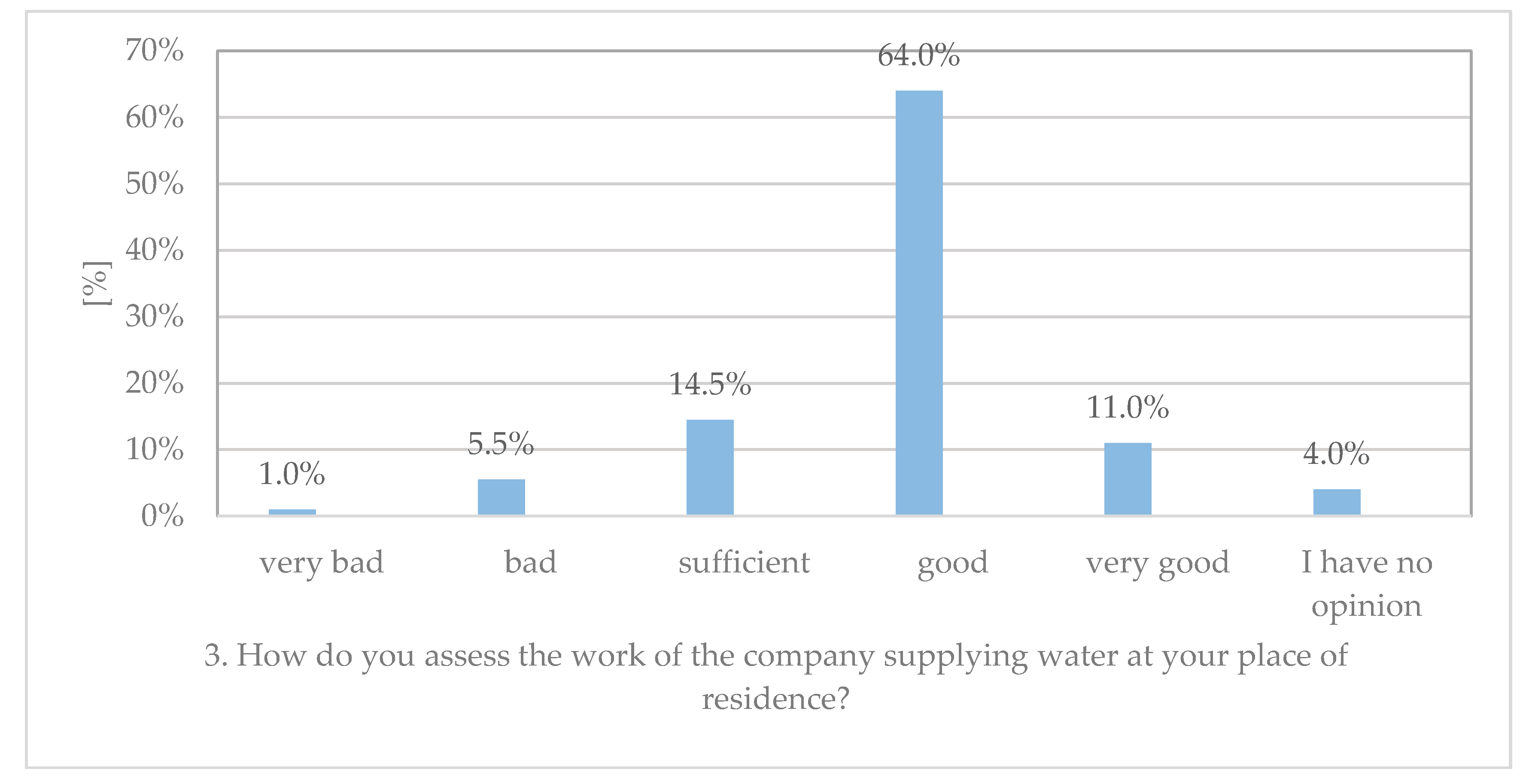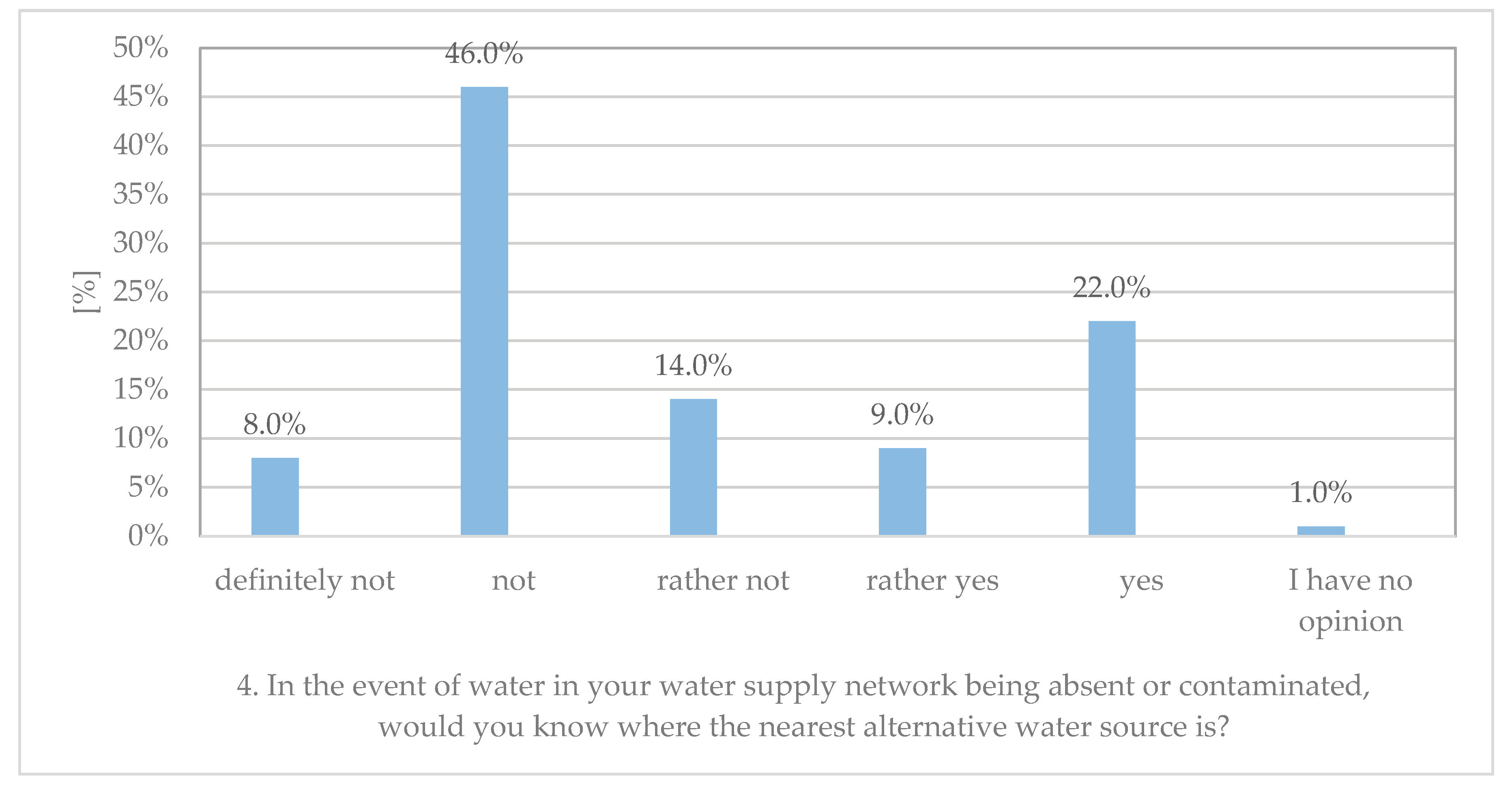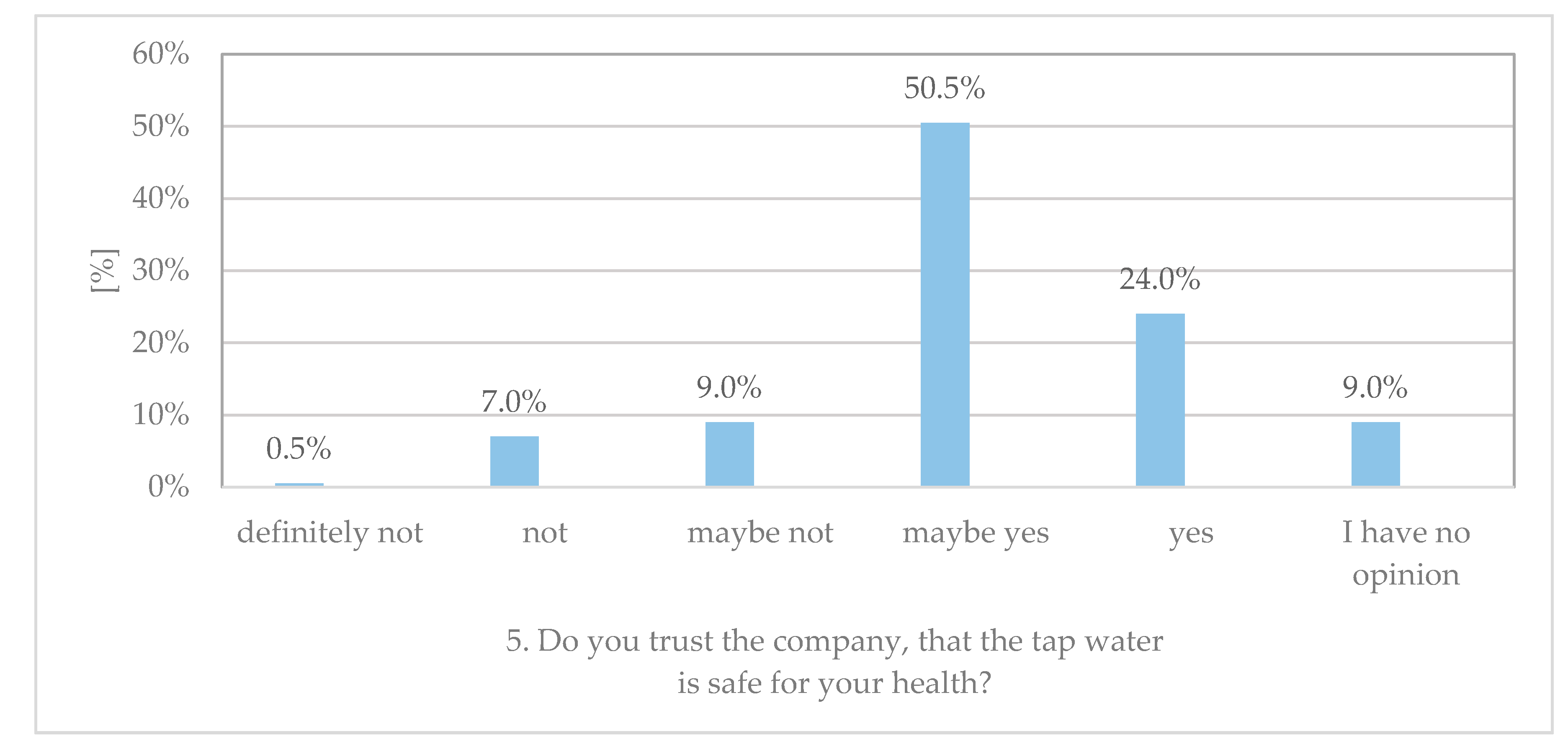An Approach to Analysing Water Consumers’ Acceptance of Risk-Reduction Costs
Abstract
1. Introduction
- Developing emergency plans in the event of failures of various kinds;
- Securing the work of means of communication and an alarm notification network;
- Arranging the supply of water from alternative sources (e.g., water delivery to housing estates in water tankers);
- Providing basic medical and sanitary measures (e.g., for water supply);
- Providing resources as part of external support (e.g., in the supply of bottled water to the population);
- Organising preventive inspections aimed at assessing the state of emergency protection and identifying potential new causes of failures;
- Developing a crew-training system in the event of a crisis, including periodic civil-defence exercises.
- Assumed cost of preventing undesirable events, the so-called ICAF—Implied Cost of Averting a Fatality:
- An indicator called the Cost of Unit Risk Reduction—CURR:
2. Criteria for Risk Acceptance as an Element of Risk Management
- Systemic solutions (e.g., modernisation of the system, alternative water sources kept in constant readiness, emergency capacity in water tanks, correction of water treatment technology, redesign of the water supply network, alternative energy sources, reserving strategic network facilities, and the introduction of remote supervision and system control using GIS);
- Technical and complementary protective measures (the introduction of a multi-barrier system, i.e., an early, delayed, or late warning system);
- Information for water consumers.
- The area below the lower limit, i.e., of widely tolerated risk;
- The area above the upper limit, i.e., of unacceptable risk;
- The ALARP area between the two given boundaries.
3. Materials and Methods
3.1. Materials
3.2. Assumptions Underpinning the Method Analysing Consumers’ Acceptance of Risk-Reduction Costs
- Qi is a consumers’ assessment of drinking water quality, for i = 1, 2, 3;
- Pj is an assessment related to the acceptance of water prices by consumers, for j = 1, 2, 3;
- Tk is an assessment related to the degree of trust and knowledge of water consumers as regards activities carried out by a water supply company, including the trust that tap water is safe for health, for k = 1, 2, 3.
- High-scale (when ARI takes values equals or higher than 12), ARIh = {ARI322, ARI223, ARI323, ARI232, ARI322, ARI233, ARI333}.
- Average-scale (when ARI takes values from 6 to 12), ARIa = {ARI312, ARI213, ARI313, ARI321, ARI222, ARI123, ARI231, ARI331, ARI132, ARI133}.
- Low-scale (when ARI takes values less than 6), ARIl = {ARI111, ARI211, ARI311, ARI112, ARI212, ARI113, ARI121, ARI221, ARI122, ARI131}.
- If the ARI level is classified as high on the scale provided, this denotes acceptance by consumers of the costs incurred by the water supply company.
- If, on a given scale, the level of ARI is classified as medium, this means that the costs incurred by the water supply company are tolerated by consumers. However, the company should pursue an information campaign to convince consumers of the necessity of the new measures being applied.
- If the ARI level is classified as low on the scale provided, this means that the costs incurred by the water supply company are not accepted by water consumers. The company should verify its action plan and make adjustments in the design phase.
3.3. Results of Research
- Around 65% of respondents assess the quality of tap water, the work of the water supply company (75%), and the quality of water resources (47%) as good and very good;
- Around 67% of respondents have not experienced a related nuisance with a lack—or poor quality—of tap water (87%);
- Over 80% of respondents declare that they save water;
- Around 68% of respondents do not know where alternative water sources are located.
- Answers to Question 2 (Figure 4) indicate that about 48.5% of respondents approve of the price of water in the city, and about 44% of them do not accept it, or “rather” do not accept it. On this basis, in line with the data in Table 1, it was assumed that assessment is at the average level (P2 = 2),
- Consumer confidence and communication of the water supply company with water consumers: To estimate this assessment, the answers to Questions 3–6 included in Table 4 were analysed (Figure 5, Figure 6, Figure 7 and Figure 8). Based on these research results, it can be concluded that about 74.5% of respondents accept and evaluate the activities of the water supply company favourably or very favourably. The results also showed that about 60% of those answering did not know about alternative water sources in the city. Based on the results of the analyses, it was assumed that this assessment assumes the average value (T3 = 2).
4. Conclusions
Author Contributions
Funding
Acknowledgments
Conflicts of Interest
References and Notes
- Kaplan, S.; Garrick, B.J. On the quantitative definition of risk. Risk Anal. 1981, 1, 11–27. [Google Scholar] [CrossRef]
- Merkel, W.; Castell-Exner, C. Managing risk under normal operation and in crisis situations. Water Util. Manag. Int. 2010, 9, 19–22. [Google Scholar]
- Pollard, S.J.T.; Strutt, J.E.; Macgillivray, B.H.; Hamilton, P.H.; Hrudey, S.E. Risk analysis and management in the water utility sector-a review of drivers, tools and techniques. Process Saf. Environ. Prot. 2008, 82, 1–10. [Google Scholar]
- Drinking Water Directive (Council Directive 98/83/EC of 3 November 1998 on the Quality of Water Intended for Human Consumption), with Its Latest Amendments Including Commission Directive (EU) 2015/1787 of 6 October 2015. Available online: https://ec.europa.eu/environment/water/water-drink/legislation_en.html (accessed on 6 November 2020).
- Council Directive 2008/114/EC of 8 December 2008 on the Identification and Designation of European Critical Infrastructures and the Assessment of the Need to Improve Their Protection, OJ L 345, 23.12.2008. Available online: https://eur-lex.europa.eu/LexUriServ/LexUriServ.do?uri=OJ:L:2008:345:0075:0082:EN:PDF (accessed on 6 November 2020).
- Molinos-Senante, M.; Maziotis, A.; Sala-Garrido, R. Estimating the cost of improving service quality in water supply: A shadow price approach for England and Wales. Sci. Total Environ. 2016, 539, 470–477. [Google Scholar] [CrossRef] [PubMed]
- Chen, B.P.-T.; Chen, C.-S. Feasibility Assessment of a Water Supply Reliability Index for Water Resources Project Planning and Evaluation. Water 2019, 11, 1977. [Google Scholar] [CrossRef]
- Rogers, J.W.; Garrick, E.; Louis, G.E. Risk and opportunity in upgrading the US drinking water infrastructure system. J. Environ. Manag. 2008, 87, 26–36. [Google Scholar] [CrossRef]
- World Health Organization. Guidelines for Drinking-Water Quality, 4th ed.; World Health Organization: Geneva, Switzerland, 2011. [Google Scholar]
- Tchórzewska-Cieślak, B.; Pietrucha-Urbanik, K. Failure risk analysis in the collective water supply systems in crisis situations. J. Pol. Saf. Reliab. Assoc. 2013, 1, 129–136. [Google Scholar]
- Mays, L.W. The Role of Risk Analysis in Water Resources Engineering; Arizona State University: Tempe, AZ, USA, 2005. [Google Scholar]
- Tanyimboh, T.T.; Burd, R.; Burrows, R.; Tabesh, M. Modelling and reliability analysis of water distribution systems. Water Sci. Technol. 1999, 39, 249–255. [Google Scholar] [CrossRef]
- Hrudey, S.E. Drinking water quality–a risk management approach. Water 2001, 26, 29–32. [Google Scholar]
- Schramm, V.B.; Schramm, F. An Approach for Supporting Problem Structuring in Water Resources Management and Planning. Water Resour. Manag. 2018, 9, 2955–2968. [Google Scholar] [CrossRef]
- Su, H.-T.; Tung, Y.-K. Comparisons of Risk-based Decision Rules for the Application of Water Resources Planning and Management. Water Resour. Manag. 2014, 12, 3921–3935. [Google Scholar] [CrossRef]
- Lee, S.; Oak, S.; Jung, D.; Jun, H. Development of Failure Cause–Impact–Duration (CID) Plots for Water Supply and Distribution System Management. Water 2019, 11, 1719. [Google Scholar] [CrossRef]
- Tchórzewska-Cieślak, B. Estimation of acceptance of the costs of risk associated with the operation of the water supply system. Ochr. Srodow. 2007, 7, 69–72. [Google Scholar]
- Shinstine, D.S.; Ahmed, I.; Lansey, K. Reliability/availability analysis of municipal water distribution networks: Case Studies. J. Water Resour. Plan. Manag. 2002, 128, 140–151. [Google Scholar] [CrossRef]
- Kordana, S.; Słyś, D. Decision Criteria for the Development of Stormwater Management Systems in Poland. Resources 2020, 9, 20. [Google Scholar] [CrossRef]
- Quimpo, R.; Wu, S. Condition assessment of water supply infrastructure. J. Inf. Syst. 1997, 3, 15–20. [Google Scholar] [CrossRef]
- Grbčić, L.; Lučin, I.; Kranjčević, L.; Družeta, S. A Machine Learning-based Algorithm for Water Network Contamination Source Localization. Sensors 2020, 20, 2613. [Google Scholar] [CrossRef] [PubMed]
- Martin-Candilejo, A.; Santillán, D.; Iglesias, A.; Garrote, L. Optimization of the Design of Water Distribution Systems for Variable Pumping Flow Rates. Water 2020, 12, 359. [Google Scholar] [CrossRef]
- Cao, Y.; Zhang, W.; Ren, J. Efficiency Analysis of the Input for Water-Saving Agriculture in China. Water 2020, 12, 207. [Google Scholar] [CrossRef]
- Rak, J. Selected problems of water supply safety. Environ. Prot. Eng. 2009, 2, 23–28. [Google Scholar]
- Rak, J.; Tchórzewska-Cieślak, B. Review of matrix methods for risk assessment in water supply system. J. Konbin 2006, 1, 67–76. [Google Scholar]
- Dettori, M.; Pittaluga, P.; Busonera, G.; Gugliotta, C.; Azara, A.; Piana, A.; Arghittu, A.; Castiglia, P. Environmental Risks Perception Among Citizens Living Near Industrial Plants: A Cross-Sectional Study. Int. J. Environ. Res. Public Health 2020, 17, 4870. [Google Scholar] [CrossRef] [PubMed]
- Di Bona, G.; Forcina, A.; Falcone, D.; Silvestri, L. Critical Risks Method (CRM): A New Safety Allocation Approach for a Critical Infrastructure. Sustainability 2020, 12, 4949. [Google Scholar] [CrossRef]
- Tiganoaia, B.; Niculescu, A.; Negoita, O.; Popescu, M. A New Sustainable Model for Risk Management—RiMM. Sustainability 2019, 11, 1178. [Google Scholar] [CrossRef]
- Maziotis, A.; Villegas, A.; Molinos-Senante, M. The cost of reducing unplanned water supply interruptions: A parametric shadow price approach. Sci. Total Environ. 2020, 719, 137487. [Google Scholar] [CrossRef]
- Molinos-Senante, M.; Sala-Garrido, R. How much should customers be compensated for interruptions in the drinking water supply? Sci. Total Environ. 2017, 586, 642–649. [Google Scholar] [CrossRef]
- EN 15975-1. Security of drinking water supply. Guidelines for risk and crisis management. Part 1 Crisis management.
- EN 15975-2. Security of drinking water supply. Guidelines for risk and crisis management. Part 2. Risk management.
- Haimes, Y.Y.; Li, Y. Risk Modeling, Assessment and Management; Wiley: New York, NY, USA, 1998. [Google Scholar]
- Hastak, H.; Baim, E. Risk factors affecting management and maintenance cost of urban infrastructure. J. Inf. Syst. 2001, 7, 67–75. [Google Scholar] [CrossRef]
- Tchórzewska-Cieślak, B. Methods for Analyzing and Assessing the Risk of Failure of the Water Distribution Subsystem; Rzeszów University of Technology Publishing House: Rzeszow, Poland, 2011. [Google Scholar]
- Grey-Gardner, G. Implementing risk management for a water supplies, a catalyst and incentive for change. Rangel. J. 2008, 30, 149–156. [Google Scholar] [CrossRef]
- Geng, Z.Q.; Chen, N.; Han, Y.M.; Ma, B. An improved intelligent early warning method based on MWSPCA and its application in complex chemical processes. Can. J. Chem. Eng. 2020, 98, 1307–1318. [Google Scholar] [CrossRef]
- Duan, W.; He, B.; Nover, D.; Yang, G.; Chen, W.; Meng, H.; Zou, S.; Liu, C. Water Quality Assessment and Pollution Source Identification of the Eastern Poyang Lake Basin Using Multivariate Statistical Methods. Sustainability 2016, 8, 133. [Google Scholar] [CrossRef]
- Geng, Z.; Hu, X.; Han, Y.; Yanhua, Z. A Novel Leakage-Detection Method Based on Sensitivity Matrix of Pipe Flow: Case Study of Water Distribution Systems. J. Water Resour. Plan. Manag. ASCE 2019, 145, 04018094. [Google Scholar] [CrossRef]
- Geng, Z.Q.; Wang, Z.; Hu, H.X.; Han, Y.M.; Lin, X.Y.; Zhong, Y.H. A fault detection method based on horizontal visibility graph-integrated complex networks: Application to complex chemical processes. Can. J. Chem. Eng. 2019, 97, 1129–1138. [Google Scholar] [CrossRef]
- Bondoc, I. European Regulation in the Veterinary Sanitary and Food Safety Area, a Component of the European Policies on the Safety of Food Products and the Protection of Consumer Interests: A 2007 Retrospective. Part One: The Role of European Institutions in Laying Down and Passing Laws Specific to the Veterinary Sanitary and Food Safety Area. Universul Juridic Supliment 2016, 5, 12–15. [Google Scholar]
- Bondoc, I. European Regulation in the Veterinary Sanitary and Food Safety Area, a Component of the European Policies on the Safety of Food Products and the Protection of Consumer Interests: A 2007 Retrospective. Part Two: Regulations. Universul Juridic Supliment 2016, 5, 16–19. [Google Scholar]
- Ezell, B.; Farr, J.; Wiese, I. Infrastructure risk analysis of municipal water distribution system. J. Inf. Syst. 2000, 6, 118–122. [Google Scholar] [CrossRef]
- StatSoft, Inc. STATISTICA (Data Analysis Software System), Version 12. Available online: www.statsoft.com (accessed on 15 August 2020).
- Shuang, Q.; Liu, H.J.; Porse, E. Review of the Quantitative Resilience Methods in Water Distribution Networks. Water 2019, 11, 1189. [Google Scholar] [CrossRef]
- Pietrucha-Urbanik, K.; Rak, J.R. Consumers’ Perceptions of the Supply of Tap Water in Crisis Situations. Energies 2020, 13, 3617. [Google Scholar] [CrossRef]
- Fang, L.; Wu, F. Can Water Rights Trading Scheme Promote Regional Water Conservation in China? Evidence from a Time-Varying DID Analysis. Int. J. Environ. Res. Public Health 2020, 17, 6679. [Google Scholar] [CrossRef] [PubMed]
- Quach, S.; Thaichon, P.; Hewege, C. Triadic relationship between customers, service providers and government in a highly regulated industry. J. Retail. Consum. Serv. 2020, 55, 102148. [Google Scholar] [CrossRef]
- Franceys, R.W.A.; Gerlach, E. Consumer involvement in water services regulation. Util. Policy 2011, 19, 61–70. [Google Scholar] [CrossRef]
- Shin, S.; Lee, S.; Judi, D.R.; Parvania, M.; Goharian, E.; McPherson, T.; Burian, S.J. A Systematic Review of Quantitative Resilience Measures for Water Infrastructure Systems. Water 2018, 10, 164. [Google Scholar] [CrossRef]












| Parameter | Description of the Parameter | Point Weight |
|---|---|---|
| Degree of drinking water quality assessment Qi | big | 3 |
| average | 2 | |
| small | 1 | |
| Degree of water prices acceptance by consumers Pj | good | 3 |
| average | 2 | |
| bad | 1 | |
| Degree of water consumers’ trust Tk | high | 3 |
| average | 2 | |
| low | 1 |
| Degree of Drinking-Water Quality Assessment—Qi | |
|---|---|
| No. → Question | 1. How do you assess the quality of tap water at your place of residence? |
| Assessment | ○ very bad ○ bad ○ sufficient ○ good ○ very good ○ I have no opinion |
| Degree of the Acceptance of Water Prices by Consumers—Pj | |
|---|---|
| No. → Question | 2. Do you accept the price of water at your place of residence? |
| Assessment | ○ definitely not ○ not ○ rather not ○ rather yes ○ yes ○ I have no opinion |
| Degree of Trust of Water Consumers—Tk | |
|---|---|
| No. → Question | 3. How do you assess the work of the company supplying water at your place of residence? |
| Assessment | ○ very bad ○ bad ○ sufficient ○ good ○ very good ○ I have no opinion |
| No. → Question | 4. In the event of water in your water supply network being absent or contaminated, would you know where the nearest alternative water source is? |
| Assessment | ○ definitely not ○ not ○ rather not ○ rather yes ○ yes ○ I have no opinion |
| No. → Question | 5. Do you trust the company, that the tap water is safe for your health? |
| Assessment | ○ definitely not ○ not ○ maybe not ○ maybe yes ○ yes ○ I have no opinion |
| No. → Question | 6. Do you accept the activities of the water supply company carried out in order to modernise, expand and renovate the water supply system at your place of residence? |
| Assessment | ○ definitely not ○ not ○ rather not ○ rather yes ○ yes ○ I have no opinion |
| Consumer Knowledge Regarding the City’s Water Supply | |
|---|---|
| No. → Question | 7. Have you experienced any nuisance related to the lack of tap water? |
| Assessment | ○ definitely not ○ not ○ rather not ○ rather yes ○ yes ○ I have no opinion |
| No. → Question | 8. Have you experienced any problems related to the consumption of tap water of inadequate quality? |
| Assessment | ○ definitely not ○ not ○ rather not ○ rather yes ○ yes ○ I have no opinion |
| No. → Question | 9. Do you save water? |
| Assessment | ○ definitely not ○ not ○ rather not ○ rather yes ○ yes ○ I have no opinion |
| No. → Question | 10. How do you assess the quality of water resources in the region? |
| Assessment | ○ definitely not ○ not ○ rather not ○ rather yes ○ yes ○ I have no opinion |
Publisher’s Note: MDPI stays neutral with regard to jurisdictional claims in published maps and institutional affiliations. |
© 2020 by the authors. Licensee MDPI, Basel, Switzerland. This article is an open access article distributed under the terms and conditions of the Creative Commons Attribution (CC BY) license (http://creativecommons.org/licenses/by/4.0/).
Share and Cite
Tchórzewska-Cieślak, B.; Pietrucha-Urbanik, K.; Kuliczkowska, E. An Approach to Analysing Water Consumers’ Acceptance of Risk-Reduction Costs. Resources 2020, 9, 132. https://doi.org/10.3390/resources9110132
Tchórzewska-Cieślak B, Pietrucha-Urbanik K, Kuliczkowska E. An Approach to Analysing Water Consumers’ Acceptance of Risk-Reduction Costs. Resources. 2020; 9(11):132. https://doi.org/10.3390/resources9110132
Chicago/Turabian StyleTchórzewska-Cieślak, Barbara, Katarzyna Pietrucha-Urbanik, and Emilia Kuliczkowska. 2020. "An Approach to Analysing Water Consumers’ Acceptance of Risk-Reduction Costs" Resources 9, no. 11: 132. https://doi.org/10.3390/resources9110132
APA StyleTchórzewska-Cieślak, B., Pietrucha-Urbanik, K., & Kuliczkowska, E. (2020). An Approach to Analysing Water Consumers’ Acceptance of Risk-Reduction Costs. Resources, 9(11), 132. https://doi.org/10.3390/resources9110132







